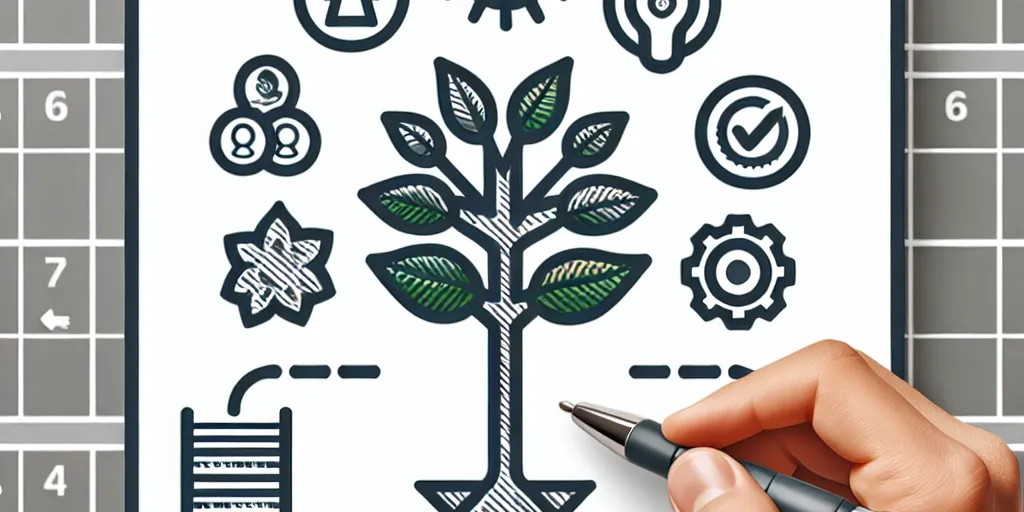· Seren Marlowe · self discovery and potential · 11 min read
Crafting Your Journey: A Guide to Creating a Powerful Personal Development Plan
Unlock Your Potential with a Tailored Growth Strategy

You’ve probably heard that a journey of a thousand miles begins with a single step. But what if I told you there’s a way to make your steps even more purposeful? That’s where a Personal Development Plan (PDP) comes into play. It’s not just about taking steps; it’s about taking the right steps for you. In this guide, I’m going to walk you through the nitty-gritty of creating a PDP that’s as unique as your fingerprint, geared to set you on a path of growth, learning, and pure awesomeness. So, let’s grab our mental backpacks and start this adventure, shall we?
Let’s dive into the components of this guide. Below is a roadmap to all the sections we’ll explore. Feel free to hop around or read in order – whatever floats your boat!
- Understanding Personal Development Plans
- Self-Assessment: The Bedrock of Your Plan
- Vision Setting: Imagining the Future You
- Goal Mapping: Turning Dreams into Realities
- Skill Building: Equipping Yourself for the Journey
- Action Steps: The Path from Here to There
- Monitoring Progress: Tracking Your Growth
- Overcoming Challenges: Staying Resilient
- Review and Adaptation: The Art of Evolution
Understanding Personal Development Plans
When you hear the term Personal Development Plan (PDP), think of it as your very own roadmap to success. Imagine you’re heading on a cross-country road trip; you wouldn’t just hop in the car and drive aimlessly, right? You’d have a map, a GPS, and some pit stops planned out to ensure you reach your destination efficiently and with a bit of fun along the way. Similarly, a PDP guides you through the landscape of life, setting out clear milestones and providing direction.
- Clarity of Purpose: A PDP helps clarify what you truly want to achieve, aligning your efforts with your innermost desires.
- Goal Achievement: It breaks down your aspirations into tangible goals, making them more attainable.
- Self-Awareness: This plan acts as a mirror, reflecting your strengths, weaknesses, and potential areas of growth.
Anecdote time: when I first scribbled down my ‘wishful thoughts’—which were all over the place, I might add—it wasn’t until I crafted a solid plan that those wishes started to morph into realities. It was as if the universe got a clear signal of my intentions, and the path unfolded before me with each step I took, anchored by my trusty PDP.
Self-Assessment: The Bedrock of Your Plan
 Welcome to the cornerstone of your personal development plan: Self-Assessment. Much like you wouldn’t build a house on shaky ground, embarking on your personal development journey requires a sturdy foundation of self-awareness. This step is all about holding up a mirror to your soul and getting up close and personal with who you are, warts and all.
Welcome to the cornerstone of your personal development plan: Self-Assessment. Much like you wouldn’t build a house on shaky ground, embarking on your personal development journey requires a sturdy foundation of self-awareness. This step is all about holding up a mirror to your soul and getting up close and personal with who you are, warts and all.
It’s a time for honest reflection, asking yourself the hard-hitting questions: What are my strengths? What skills do I need to improve? Which habits hold me back? This isn’t just about self-critique; it’s a celebration of your uniqueness and potential. Through this process, you’re compiling an inventory of your personal assets and challenge areas, which will set the stage for every step that follows.
Here’s a little anecdote to drive it home: Last year, during my self-assessment, I realized I was great at starting projects but abysmal at finishing them. It was a sobering moment, realizing this trait was affecting all areas of my life. Armed with this knowledge, I tailored my PDP to focus on persistence and follow-through, leaning into the hard truth to forge a better me. That’s the power of self-assessment—it’s not just about knowing yourself, but also setting the GPS for your personal development journey.
Vision Setting: Imagining the Future You
Now that you’ve dug deep with some serious self-assessment, it’s time to lift your eyes to the horizon and set your Vision. Vision setting is like painting your masterpiece of the future; it’s a vivid description of the person you aspire to become. This isn’t about vague hopes or fleeting daydreams—it’s about crafting a crystal-clear image that pulls you forward, a beacon amidst the fog of everyday life.
Crafting your vision involves a few key steps:
- Think Big: Dare to dream without limits. If you could be anyone, do anything, what would that look like?
- Be Specific: General goals get general results. Get down to the nitty-gritty—what are the details of your future self?
- Emotionally Connect: A vision has to stir your soul. If it doesn’t move you, rework it until it does.
Remember, your vision is not set in stone; it’s a living, breathing destination that evolves as you grow. But for now, paint it boldly. It’s not just a picture of the future—it’s the call of the person you are meant to become.
💡 Your mindset is a mental thermostat—it sets the temperature for success. Adopting a growth mindset, where challenges are opportunities, activates the brain’s potential. It’s like turning your mind into an engine for continuous improvement, ready to rev up and conquer any roadblocks on the journey to personal development and achievement!
Goal Mapping: Turning Dreams into Realities
 With your vision set firmly in the skies, it’s time to bridge the gap between the stars of your dreams and the ground of reality with Goal Mapping. This is where those grand visions get translated into actionable, bite-sized pieces. Think of it as your personal treasure map, with ‘X’ marking the spot of your future achievements.
With your vision set firmly in the skies, it’s time to bridge the gap between the stars of your dreams and the ground of reality with Goal Mapping. This is where those grand visions get translated into actionable, bite-sized pieces. Think of it as your personal treasure map, with ‘X’ marking the spot of your future achievements.
Here’s how to map out your goals effectively:
- Break It Down: Dissect your ultimate vision into smaller, manageable goals. These should be specific, measurable, achievable, relevant, and time-bound (SMART).
- Sequence Your Steps: Determine the order in which these goals need to be tackled. Some goals are stepping stones to larger ones!
- Commit to Paper: Write down your goals. This physical act transforms them from ephemeral ideas to tangible objectives.
Let me tell you a quick story: I once dreamt of running a marathon but viewed it as a distant, almost impossible dream. It was only when I goal-mapped (first a 5K, then a 10K, and so on), that the impossible gradually became possible. Each smaller race was a mini goal leading up to the grand goal. And yes, eventually, I crossed that marathon finish line. Your dreams are achievable too; it just takes the right map to find the treasure.
Skill Building: Equipping Yourself for the Journey
As you trek towards your future self, you’ll need to equip yourself with the proper tools and gear for the journey—this is where Skill Building enters the scene. Just like a mountaineer needs a pickaxe to scale a cliff, you need to hone certain skills to conquer the challenges ahead.
First and foremost, identify the skills that will have the greatest impact on reaching your goals. Whether it’s learning how to communicate effectively, mastering a new software, or getting better at time management, these skills become your weaponry against obstacles. Here’s the approach:
- Prioritize: Focus on skills that will give you the most leverage toward your goals.
- Learn Actively: Embrace hands-on learning through practice, not just theory.
- Seek Feedback: Constructive criticism is your compass, guiding you to improve.
Keep in mind, skill building is a continuous process. It’s about lifelong learning, being curious, and consistently pushing yourself out of your comfort zone. With every new skill acquired, you’re one step closer to that grand vision you’ve set for yourself.
Action Steps: The Path from Here to There
 Think of Action Steps as the individual footsteps on the path to your ultimate destination. They translate your goals into daily, weekly, and monthly tasks, bringing your lofty aspirations down to earth—and into your calendar.
Think of Action Steps as the individual footsteps on the path to your ultimate destination. They translate your goals into daily, weekly, and monthly tasks, bringing your lofty aspirations down to earth—and into your calendar.
- Be Specific: General intentions are like trying to catch fish with your bare hands. Define precise actions—‘Write 500 words of my book each morning’ beats ‘work on my book’.
- Set Deadlines: Time constraints create urgency. A task scheduled is a task halfway done.
- Stay Flexible: Life happens, and your steps may need adjusting. Stay nimble, and pivot as needed.
Remember, action is where the magic happens. Each step you take is a mini victory that accumulates into your larger success story. Don’t underestimate the power of small, consistent actions—they are the compound interest of self-development, and over time, they’ll carry you to the peaks of your aspirations.
💡 Goals are like the GPS for your dreams. Research suggests that setting specific goals activates the brain’s reward system, propelling you towards success. It’s like programming your own success story into the universe, with each goal achieved being a satisfying checkpoint on the journey of personal triumph!
Monitoring Progress: Tracking Your Growth
In any grand adventure, it’s crucial to occasionally pause and assess where you are on the map. That’s where Monitoring Progress becomes your trusty guide. Keeping tabs on your advancement isn’t about obsessing over every little detail; it’s about recognizing your growth and adjusting your sails when necessary.
Think of monitoring your progress as taking a pulse on your journey towards personal development. You want to ensure that you’re not just moving, but moving in the right direction. Here’s how to do it effectively:
- Regular Check-ins: Schedule weekly or monthly reviews of your goals and action steps. Are you on track?
- Measure What Matters: Use metrics that truly reflect your progress towards your vision.
Keeping a journal or log can be incredibly helpful in this process. Not only does it provide a historical record of your path, but it also allows you to reflect on how far you’ve come—a powerful motivation booster. Keep your eyes on your progress, and you’ll find the rhythm of success in the dance of development.
Overcoming Challenges: Staying Resilient
Embarking on a personal development journey is akin to setting sail on the open seas. While the waters may be calm and welcoming at the outset, storms and challenges are inevitable. It’s not just about sailing; it’s about learning to weather the storms. Overcoming Challenges is about cultivating resilience—the lifejacket that keeps you afloat during turbulent times.
The key isn’t to avoid obstacles but to learn how to navigate through them. Here’s how to stay resilient:
- Expect Challenges: Understand that setbacks are a natural part of growth. Anticipating them reduces their power to demoralize you.
- Embrace a growth mindset: Challenges are opportunities for learning. Each hurdle crossed is a lesson learned and a victory won.
Building resilience is a continuous process, forged in the fires of tough times. It’s about standing firm in the face of adversity, and when knocked down, dusting yourself off and getting back up—every single time. With a resilient spirit, you transform challenges into stepping stones on the path to your aspirations.
💡 Determination is the unwavering flame within, resilient against the winds of challenge. With every setback, it grows stronger, fueled by resilience and purpose. In the symphony of life, determination plays a triumphant melody, echoing the belief that with steadfast resolve, any mountain can be climbed, and every dream can be achieved.
Review and Adaptation: The Art of Evolution
As you travel along the path of personal development, it’s important to periodically take a step back and conduct a thorough Review and Adaptation of your plan. This isn’t about second-guessing yourself; it’s about honing your strategy to perfection. The art of evolution in your personal development plan is all about adaptability and growth.
Adjusting your approach along the way is not only smart, it’s necessary. Think of it like pruning a bonsai tree, carefully guiding its shape to match your vision. Here’s how to master the art:
- Assess and Reflect: Look back at your progress. What worked? What didn’t? Take stock of both your successes and your struggles.
- Stay Open to Change: Your goals may evolve as you grow, and that’s okay. Your personal development plan is a living document, meant to change as you do.
By regularly reviewing and adapting your plan, you’re not just being reactive, you’re being proactive. You’re shaping your journey with intentionality, ensuring that with each step you take, you’re truly moving closer to the person you aim to be.
And there you have it, folks – your very own personal development plan ready to launch. Remember, it’s all about the journey, not the destination. Keep tweaking, adapting, and growing. If you ever feel stuck, glance back at this guide or reach out for a chat. Here’s to your personal growth and the great adventures ahead!





